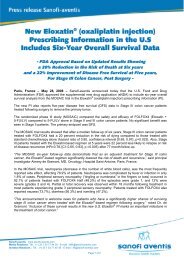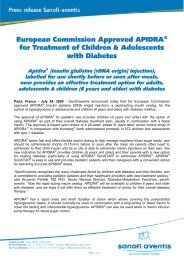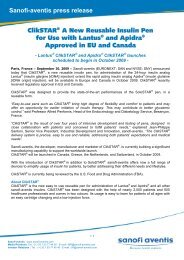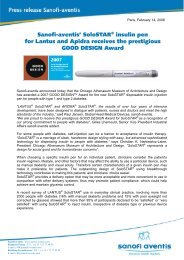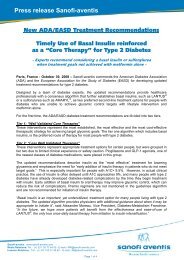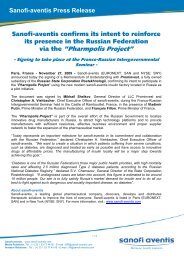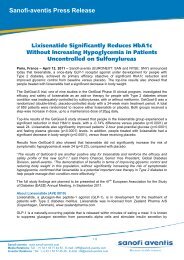Annual Report 2003 Aventis - Sanofi
Annual Report 2003 Aventis - Sanofi
Annual Report 2003 Aventis - Sanofi
Create successful ePaper yourself
Turn your PDF publications into a flip-book with our unique Google optimized e-Paper software.
Expert Opinion on Infectious Diseases<br />
What is the current status in the treatment and control of bacterial<br />
infections?<br />
The three most common respiratory infections – sinusitis, pneumonia and middleear<br />
infections – account for 75 % of all outpatient antibiotic prescriptions. But the<br />
trouble with bugs is that it’s very hard to know where they will land. Diseases can<br />
explode out of nowhere, occurring both inside and outside of hospitals. So far,<br />
we’ve more or less been able to keep up with infectious diseases. However, bacteria<br />
constantly develop resistance to antibiotics and it’s impossible to predict when<br />
resistance will occur.<br />
So our greatest concern right now is the availability of new antibiotics to combat<br />
diseases as they appear or develop increased resistance to existing treatments. Additionally,<br />
we would also benefi t from more treatments for SARS, infl uenza and other<br />
viral – as opposed to bacterial – diseases.<br />
What is your view on the new class of antibiotics known as “ketolides”?<br />
Any new class of antibiotics that helps solve the problem of resistance is welcome. The<br />
good safety profi le and oral delivery of these drugs make them especially practical,<br />
which would not be the case if we had to inject them or if they had bad side-effects.<br />
How would you assess the chances of therapeutic progress in this fi eld?<br />
The rate at which bacteria will develop resistance to antibiotics will increase. But the<br />
pipeline is drying up because pharmaceutical companies are not developing as many<br />
new antibiotics as previously. Existing drugs like Ketek, for example, are very effective<br />
in the fi ght against bugs, but new, useful treatments are becoming increasingly<br />
scarce.<br />
Looking ahead, pharmaceutical companies are likely to focus on developing<br />
anti-infectives for illnesses such as Hepatitis and HIV. Drugs for these diseases are potentially<br />
more profi table because patients take them over the course of many years,<br />
whereas minor infections can generally<br />
be cured within a week of antibiotic<br />
treatment.<br />
It’s hard to persuade drug companies<br />
to develop antibiotics. The mechanisms<br />
we have in place to guarantee the safety<br />
of drugs are arduous and expensive; it<br />
currently costs $ 800 million to get a<br />
drug to the market. With that level of investment,<br />
developing a cholesterol-lowering<br />
drug seems more attractive than<br />
working on an antibiotic for sinusitis.<br />
>> 39



